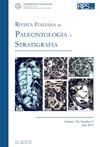LOCOMOTOR FUNCTION OF SCALES AND AXIAL SKELETON IN MIDDLE–LATE TRIASSIC SPECIES OF SAURICHTHYS (ACTINOPTERYGII)
IF 1.9
3区 地球科学
Q2 GEOLOGY
引用次数: 4
Abstract
Starting in the Late Permian, the “Triassic osteichthyan revolution” gave rise to several new morphotypes of actinopterygians, including the iconic barracuda-shaped predator Saurichthys. About 50 species, from 10 cm to over 1.5 m long, are known from mainly marine deposits worldwide. Despite current interest in Saurichthys, freshwater species and those from late Middle to early Late Triassic remain understudied. We document the postcranial morphology of three small to mid-sized (15–45 cm) species from this timeframe represented by sufficiently complete individuals: Saurichthys orientalis Sytchevskaya, 1999, from lacustrine deposits of the Madygen Formation (late Ladinian/Carnian); S. striolatus (Bronn, 1858) from the fully marine Predil Limestone (early Carnian); and S. calcaratus Griffith, 1977, from the terrigenously influenced coastal environment of the Lunz Formation (middle Carnian). S. orientalis resembles early saurichthyids in having six rows of large, thick ganoid scales; fins with segmented lepidotrichia; and flank scales relating to dorsal vertebral elements as 1:2. S. calcaratus and S. striolatus share unsegmented fin rays and a reduced scale cover with well-ossified but narrow mid-dorsal and mid-ventral scales and small, thin flank scales, relating to the dorsal arcualia as 1:1. Ventral arcualia are first described for S. calcaratus and S. striolatus, where they change in shape and number at the abdominal-caudal transition. In all three species, force transmission to the tail fin is enhanced by the caudal peduncle strengthened by a stiff structure arising from interlocking or fusion of the last enlarged mid-dorsal and mid-ventral scales (scutes), while the vertebral column remains rather lightly built.中晚三叠世放光鳍龙鳞片和轴向骨骼的运动功能
从晚二叠纪开始,“三叠纪骨鱼革命”产生了几种新的放射线鳍鱼动物形态,包括标志性的梭鱼形掠食者龙鱼。大约有50种,体长从10厘米到超过1.5米,主要生活在世界各地的海洋沉积物中。尽管目前人们对龙目鱼很感兴趣,但淡水物种和中三叠世晚期到晚三叠世早期的鱼类仍未得到充分的研究。我们记录了来自这一时期的三个中小型(15-45厘米)物种的颅后形态,并以足够完整的个体为代表:Saurichthys orientalis Sytchevskaya, 1999年,来自Madygen组(晚拉底世/卡尼世)的湖泊沉积物;S. striolatus (Bronn, 1858)来自完全海相的Predil石灰岩(卡尼期早期);S. calcaratus Griffith, 1977,来自中卡尼期Lunz组陆源影响的海岸环境。东方鱼与早期的龙鱼相似,有六排大而厚的腺样鳞片;鳍具分节鳞毛;与背部椎体相关的侧鳞片比例为1:2。S. calcaratus和S. striolatus共享无节鳍和缩小鳞盖,骨化良好但狭窄的中背和中腹鳞片和小而薄的侧翼鳞片,与背鳍的比例为1:1。腹侧弓形虫首先被描述为S. calcaratus和S. striolatus,它们在腹部-尾端转变时形状和数量发生变化。在这三个物种中,尾鳍的力传递都是通过尾鳍柄来加强的,尾鳍柄是由最后一个扩大的中背和中腹鳞片(鳞片)的联锁或融合而产生的坚硬结构来加强的,而脊柱的结构仍然相当轻。
本文章由计算机程序翻译,如有差异,请以英文原文为准。
求助全文
约1分钟内获得全文
求助全文
来源期刊
CiteScore
3.60
自引率
4.30%
发文量
28
审稿时长
>12 weeks
期刊介绍:
The Rivista Italiana di Paleontologia e Stratigrafia was founded in 1895. It publishes original papers dealing with all fields of paleontology and of stratigraphy, from Italy and the Mediterranean to the Tethys, as well across the globe from China to North America.

 求助内容:
求助内容: 应助结果提醒方式:
应助结果提醒方式:


